WW2 Soviet Minesweepers
 Soviet Navy – 327 minesweepers 1924-45
Soviet Navy – 327 minesweepers 1924-45
Introduction: Soviet Mine warfare WW2
About early Russian naval mines & tactics:
The Russians wre pioneers of mine warfare. They started to use them during the Crimean War, laying some 1,865 in the Baltic Sea to channel enemy ships into the path of fortification’s heavy guns. This was basically the bedrock of coastal defense at the time and that tactic stayed valid for decades. Mines however claimed no ship, but their presence alone prevented a Royal Navy raid on Kronshtadt itself, which was spared the fate of other fortifications in the area orr the black sea. Another occasion to use mines surged during the Russo-Turkish War of 1877-78. In total, 1,218 mines were laid down in the black sea, to protect ports and the mouth of the Danube river, claiming one Turkish vessel.
The third occasion, and probably the best remembered was at the occasion of the Russo-Japanese War of 1905: Mines became in effect the most effective naval weapons in the Russian arsenal, claiming in fact way more IJN warships than the fleet. In all, 4,275 mines were laid down, claiming two Japanese battleships, two cruisers, five gunboats, six destroyers and a dispatch vessels and giving the world a lesson all navies were made fully aware of. Soon, minesweeping was perfected, and nets were carried by capital ships at anchor.
Russian Mine warfare in WWI
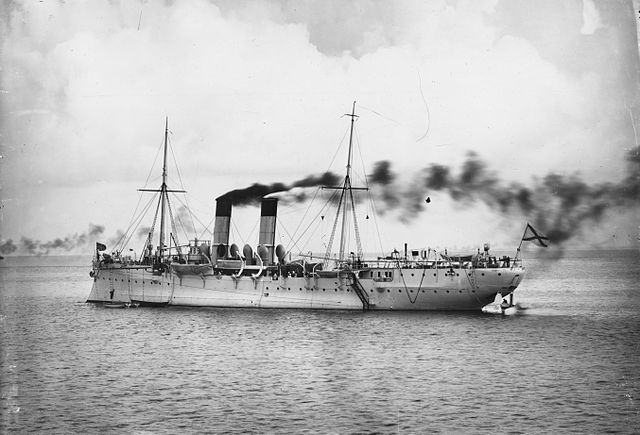
The minelayer Amur (sunk in 1904)
After 1905, the Russian Navy, almost amputated from half of its naval power more than ever bet on mines to defend its interests. When World War One brok out in August 1914, the Russian expertise reached its pinnacle during World War I. Due to the discrepancy of the forces in the Baltic, the Russian Navy had to resort to mine warfare as its primary offensive weapon. In the Baltic Sea, the knew a peak, with the use of 38,932 mines in the baltic alone, and new tactics by using both offensive and defensive mine fields (a concept in which fast mionelayers would precede a naval force and quickly lay a minefield directly in their path.
This cost the Kaiserliches Marine no less than 48 warships sunk, 21 warships badly damaged, results even better than in 1905. In 1916, the Baltic was infested so much by minefield that special missions were devised to send minesweepers with an escort, degenrating in battles. In 1916, eleven Hochseetorpedoboote en route to raid a Russian force was driven off by a minefield after seven had been sunk, more than 50% of the flotilla.
Many mines were also laid down in the Black sea as well, for a grand total of 52,000 mine and 64 warships sunk, including Turkish ones.And this was only for warhips, the number of enemy transports and auxiliaries lost to maines is vutally unknown wand probably in the order of 150 vessels or more. However in the post war years an assessement was made to judge the efficiency of mines. It was calucalted that it took on average 800 mines so sink a single warship.
Compared to the 308,700 mines aid by all belligerents durring WWI, this was still favourable, as it represented 1,500 mines per ship. Russian mine tactics as a result were seen twice as effective as other belligerents, but it is in part explaines by the confines of the Baltic and black sea, where numerous island channeled ships towards minefields easier. Nevertheless, the Russian were quite proficient in this art, inventing notably the “flying minefields”, as said above, directly into the path of an approaching fleet.
Russian Mine warfare in WWII
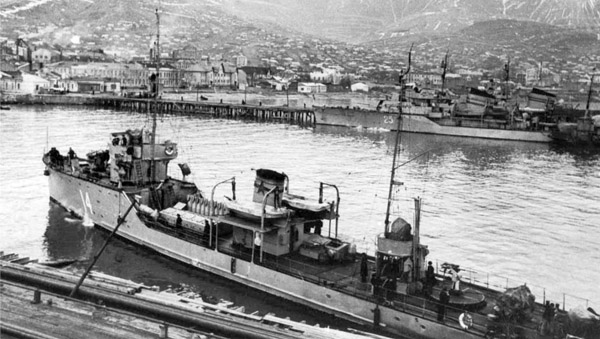
T404 in port. src: http://wio.ru
In World War II with a much reduced fleet compared to what it was in 1905 or 1914, the Soviet Navy more than ever relied on minefield to defend its coasts. But this time, with a limited success. In total, the Soviet Navy laid 40,070 mines, claiming about 200 enemy warships but also transports and auxiliares. However management of these minefield was less expert, as miscommunication and the absence of updated minefield charts claimed also many Soviet ships on their own minefields. Another reason was simply the greater success of the German land forces, claiming a large part of the Russian coast, especially in the baltic and controlling the black sea coast beyong Crimea at some point. With that few sites from which operating minelaying operations, success was hardest to come by.
Only Germany and the Soviet Union in fact included a large mine countermeasures naval force in 1939, largely in part due to their WWI experience, notably in the baltic. Both countries also had the largest mine inventories of all belligerents. The Germans took some advance in this field, exploiting the WWI early British magnetic mine technology and making their own improving model. Grand Admiral Erich Raeder failed to see their potential in 1939 and never fully exploited them at their best potential. From the summer 1941 the Baltic sea became a new battleground for mines and the Kriegsmarine was no long alaying minefields early on, a decisive factor and major hazard for Soviet shipping. Soviet minefields severely restrained Axis naval operations, especially in coastal waters. Like for other belligerents, Soviet defensive minefields concentrated around key ports and coastal areas, and minefields were laid this summer of 1941 in great numbers, all reported on top secret charts. They of course restricted maritime movements and channeled them into known “transit lanes” where submarines and MTBs can wait in ambush, and naval artillery positions.
Soviet moored mines, many dating back from WWI stocks were used until 1945 but found often drift with the tide and current. So the Soviets themselves had to perform frequent clearing missions. Another aspect of soviet mine warfare was the use of “flying minefields” litteraly so then. In WWI, small, fast motors boats were used, and in WWII the development of soviet naval aviation led to fast minelaying operations where a single squadron can lay more than 400 magnetic mines in one mission. They needed to be escorted however, and were often heavy preys for the FLAK and Luftwaffe coastal bases, using radars.
Soviet Minesweepers were built before the war, but few: One in 1924, another in 1926, but the first real effort was made with the Tral class od coastal minesweepers, of which production started in 1935, integrated into the 5-year naval plan. It stopped in 1940 after 48 ships had been delivered. They formed the backbone of the Soviet Navy, however in 1937 already, the admiralty expressed its will to give its fleet dedicated, fast and long range minesweepers. Designed in 1938, they were launched in 1940-41, some completed only after the war has ended: The Vladimir Polukhin class. Limited industrial resources during WW2 only allwoed the construction of small ships. Thus was the case of the third last Soviet minesweeper class of that war: The 200+ T class coastal steel minesweepers, the T-297, T-301, T371 classes which formed the backbone of such operations in the baltic and black sea. Let’s not forget either lend-lease vessels: The Lekryev (T111) class, ex-US Admirable class in 1943, the T-108 (various) in 1944 and the larger T-151 (YMS type) in 1945.
Technical history
The first Russian mines used contact fuzes, and some even shore control (by cable) plus simple gunpowder. In 1876-1908 galvanic caps started to be use so that mines became fully independent, and their fuse used both platinum or an electrical device as a trigger. The common explosive in 1876 became gun cotton. Past 1908 mechanical percussion for their primed fuzing was used and TNT as explosive. Eventually magnetic mines were introduced from 1939, used until 1942. Russia was also a pioneer in minesweeping. During WWI, they invented the Oropesa sweep, essentially a “wire sweep” trailed behind the minesweeper, cutting cables circa eighty meters from the ship. Generally each vessels carried two sweeps, for each side. The Soviet Navy also provided its cruisers and destroyers paravanes, this time to have them trailed from the bow. Each flotilla had a lead ship for the sweep formation, guiding all vessels in the minefield. 10% of them were sunk in action, but the training vessels at the rear, needed also to avoid and destroy the mines cut out by the lead formation. The Oropesa gear was only soccessful against moored mines, like the Paravane. German bottom magnetic mines led to the Soviets to develop an influence sweep gear, which plans were passed via lend-lease by the British having paid a great price to them in the early weeks WW2.
Designations
Before 1939 the designation used only model year, but in WW2, Soviet mines had a letter code related to their use, KB for examples stands for Korabel’naya (“shipbone”) Mina, whereas submarine-launched mines had the prefix “PL” (for “Podvodnaya Lodka”) plus extra codes reflecting some special features. Magnetic mines were designated AMD followed by and identification number.
Russian Mines in service:
Model 1908: 1268 lbs with 254 lbs (115 kg) TNT warhead, 5 Hertz horns, max depht 360 feet (110 m): The was the standard Russian mine of WWI, used with multiple iterations until the 1960s.
Model 1912: 1323 lbs. (600 kg), 221 lbs. (100 kg) warhead, max depht, 425 feet (130 m), mod M1909 with hydrostatic system for automatic depth setting
P-13: Floating mine with electrical flotation system prototype
“Rybka” 1915: Small 418.9 lbs. (190 kg) 20-27 lbs. (9 – 12 kg) warhead, percussion mechanical fuze, max depht425 feet (130 m), riverine mine.
PL-100 1915: 221 lbs. (100 kg) warhead, percussion mechanical fuze, max depht 425 feet (130 m), submarine model, tube-launched.
Model 1916: 1654 lbs. (750 kg), warhead 254 lbs. (115 kg), trigger 5 Hertz horns, max depht 1,400 feet (425 m), great depht moored contact model.
Model 1926: 2,116 lbs. (960 kg), 551 lbs. (250 kg) warhead, percussion mechanical fuze max depht 425 feet (130 m). Main Soviet interwar model and by June 1941 (26,823 in storage). 16,794 were laid down in 1941 alone.
MAB-1 (1932): Warhead 253 lbs. (100 kg), percussion mechanical fuze, max dpt.425 feet (130 m) aircraft laid mine.
Model 1908/39: 1,305 lbs, wh 254 lbs. 5 Hertz horns dpt 390 feet (120 m)
Mirab, 1939: 617 lbs. wh 141 lbs. dpt 50 feet (15 m) Magnetic aircraft mine.
R-1, 1939: 606 lbs. wh 88 lbs. (40 kg) dp 130 feet (40 m), main river mine
AMG-1, 1939: wh 552 lbs. (250 kg), Aircraft laid mine.
KB, 1940: 2347.9 lbs. wh 507 lbs. dp 850 feet. Best mine of the war.
AG 1940: 2469 lbs. wh 508 lbs. 0-2 Bronze antenna fuzes, 5 Hertz horns dpt 1,575 feet (480 m)
PLT, 1940: 1,808 lbs. wh 529 lbs. Percussion mechanical fuze, dpt 425 feet (130 m)
EhP, 1941: 2,315 lbs. wh 661 lbs, 5 Hertz horns dpt. 525 feet (160 m), for K-class large submarines.
A Mark IV 1941: 1,479 lbs. wh 728 lbs. Magnetic fuze. British lend-lease model.
A Mark V, 1941: 1,003 lbs. wh 617 lbs. Magnetic fuze. Same
PLT-2, 1942: 1,686 lbs. wh 661 lbs. 5 Hertz horns. Submarine launched.
PLT-3, 1942: Submarine mine compat. 533 mm (21″) torpedo tubes.
AMD-1-500 1942: 1,102 lbs. wh 661 lbs. 20-100 feet, magnetic small mine.
AMD-1-1000 1942: 2,205 lbs. wh 1,543 lbs. dpt 20-100 feet Magnetic aircraft/ship mine.
YaM 1943: 379 lbs. (172 kg) wh 44 lbs. Hertz fuze dpt 164 feet (50 m) coastal mine.
PLT-G 1943: 1,808 lbs. wh 529 lbs. dpt 855 feet, deep water mine.
EhP-G 1943: 2,315 lbs. 573 lbs. 5 Hertz horns 1,150 feet EhP mine mod.
AGSB, 1944: 2469 lbs. 507 lbs. 0-2 antenna fuzes, 5 Hertz horns dpt 1,640 feet anti-submarine mine.
AMD-2-500 1945: 1,102 lbs. 661 lbs. 20-165 feet, Magnetic, acoustic.
AMD-2 1000 1945: 2,205 lbs. wh 1,543 lbs. 20-165 feet, Magnetic-acoustic.
WW2 Soviet minesweepers in action (examples)
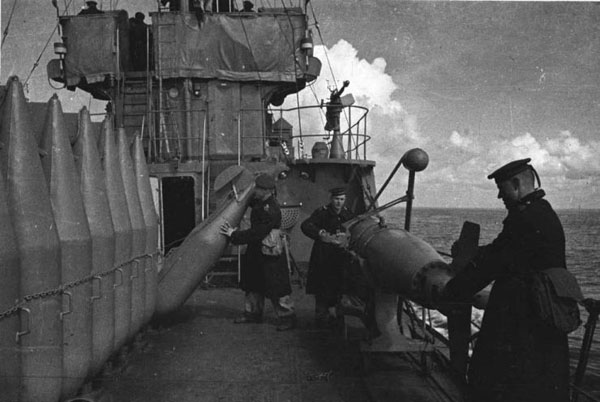
Minelaying Operation in the baltic – src http://wio.ru
Actions in the baltic:
-On 22-23 June 1941 Tszcz-201 (Fugas class) laid a 206 minefield off Libau, sinking the submarine hunter UJ-113, patrol ship V-309 Martin Donandt, minesweeper M-1708 Aldebaran, and M-1706 Gertrude.
On 19 July 1941 small naval clash between the Finnish MTBs Raju, Syoksy, Vinha and Tszcz-202: Missed, but Vinha hit and towed away by Raju.
-On 11 July 1942 Tszcz-205 Gafel and Tszcz-207 Shpil escorted the guardship Burya, during the Battle of Someri Island but eventually did not took part in the battle.
Second Battle of Nerva
On 16 July 1944 the Minesweepers Tszcz-211 Rym and Tszcz-217 (Counter-Admiral Yurkovskiy) and guard boat Tucha engaged the T-30, T-8 and T-10 (Elbing class) with hits on both sides but the Germans retreated, resulting in a tactical soviet victory, with the T-30 sunk.
First Battle of Cape Sorve
Other engagement between German minesweeper M-328 and four smaller auxiliary minesweepers, against four Fugas (Tral) class units. Tszcz-207 Shpil hit M-328. Soviet gunboats Volga, Bureya and Zeya intervened and the Germans retreated. The Second Battle of Cape Sorve was won without mineweepers.
Black Sea
-Minefield laid by Tszcz-404 Shchit off Odessa harbor, before 16 October 1941, claiming a harbor tug on 22 April 1942. Another was laid by Tszcz-405 Vzryvatel claiming the German landing barrge F-145 on 3 June 1942. Tszcz-404 Shchit and Tszcz-408 Yakor laid mines in the same area on 24 October 1941 claiming the German auxiliary minesweeper Drossel and Brusterort, the German minelayer Theresia Wallner. On 10 June 1942 Tszcz-410 Vzryv duelled with the Italian MAS-570.
Battle of Fidonisi, 13 December 1942: Tszcz-408 Yakor and Tszcz-412 Arseniy Rasskin engaged the Romanian torpedo boat Smeul escorting merchants Tsar Ferdinand (1994 GRT) and Oituz (2686 GRT). Exchanged on both sides but apparently no hits. The Soviet minesweepers spotted approaching R-boats and reterated. On 27 February 1943 Tszcz-403 Gruz was sunk by S-28, S-51, S-72 and S-102. The tug Mius and gunboat Krasnaya Gruziya were badly damaged and later sunk. On 31 March 1943, U-24 was caught on surface and hit by minesweepers Tszcz-406 Iskratel, Tszcz-407 Mina and Tszcz-409 Garpun assisted by two seaplanes MBR-2 which attacked her with with depth charges. On 24 October 1943 the same was depth charged again by Tszcz-401 Tral and Tszcz-412 Arseniy Rasskin.
Actions in the Arctic:
-30 November 1939: Tszcz-895 and Tszcz-897 seized two abandoned Finnish motorboats (Rybachi peninsula) and on 19 July 1941 Tszcz-31 shot down a Ju-87 Stuka. Crew MIA. On 5 September 1944
U-362 was attacked and sunk with depth charges by Tszcz-116 (Of the lend-lease Admirable type).
Actions with the Pacific fleet:
-24 August 1945: Tszcz-155 (auxiliary) captured a Japanese schooner. The 28, T-589 and T-590 (lend-lease) had landing parties capturing five Japanese barges in Kuriles Islands and on the 31, T-590 captured a Japanese schooner, all in the Kuriles islands
WW1/Interwar Minelayers/Minesweepers
Part of the ships dedicated to mine warfare in 1941 were ships built more than 20 years ago, already veteran of the last war. We will have a quick review of these here. They will be treated in detail in the WWI section.
WWI era Minelayers
Bug class (1891) Old masted mine transport built in 1891. Bug and Dunai were fitted for minelaying in 1907 and both deployed with the black sea fleet. Bug scuttled in Sevastopol during the Potemkine mutiny to avoid mine explosion, and raised in 1907. Both served in WWI, Dunai was rearmed and still in service in 1941, renamed Maya since 1922, but her status in unsure afterwards.
ZAGRADITEL (1906) Built in Crichtn, Abo NyD, this was a 388 tons mine transport, reclassed as a survey vessel 2.1927, a netlayer 7.1941,and survey vessel again on 10.1941.
VOLGA (1909) 6,500 tonnes Minelayer (230 mines) from New Admiralty, St. Petersburg. She became a TS in 10.1922 and a depot ship 12.1938, extant WW2 and from 1944 back to civilian duties.
Amur class (1909) Amur and Ienisei were 2,926 tonnes ships, 320 mines from Baltic Wks, St. Petersburg. The second was sunk in June 1915, the first became a depot ship in May 1938, extant WW2.
Voin (1916) Built in Kononna Yard, she was sold in 1918 to Finland, renamed M1 and then Louhi (see Finland WW2). She was lost in 1945 (mine).
WW1/Interwar Netlayers
Demosfen class netlayers (1917): Eight ships, built in Nizhegorodskiy Teplokhod, Nizhniy Novgorod.Iset, and Kolomna S Yd (Kuban subgroup): Kivach, Kuban, Luga, and Demosfen, later Prypiat. Carried 100 mines, Most captured by Finland in 1918. The rest discarded in the interwar. Quikcspecs: 320 tonnes, 47.5 x 8.00 x 1.47, 2 shafts diesels 400 bhp, 8.5 kts, 2x 75mm/48 Canet guns, 6x 7.6mm MGs, 60 mines
BEREZINA class netlayers (1918-1919): Two ships built at Kolomna S Yd from 1916, completed by the “reds”. The first was a minesweeper 5.1920, a netlayer 10.1923 and stricken on 8.1926, the second a minesweeper 5.1920, a netlayer on 10.1923, and Training Ships in 5.1926, a dispatch vessel 8.1929, and TS again in 1930, and depot ship 9.1939, extant WW2. Quickspecs: Displacement 380/450 tons FL, 50.7x 8.8 max (16.7 wheels) x 2.00, side wheels powered by 2 diesels 600 bhp, 7.5 tons fuel, 2000(6.5) nm; Armed with 2x 75mm/48 Canet guns, 2x 7.6mm/94 MGs and 120 mines. Crew 47.
Three more ships were ordered to Baltic Wks, Petrograd, laid down in 1917 but cancelled in 1918. The Kivach class would have been 480 tons, diesel-powered 60 m long vessels armed with three 102mm/60 guns, one 76mm/28 Lender AA guns, two 7.6mm MGs and 80 mines.
WWI era Minesweepers
Fugas class (1910): 150 tons, 45m vessels, carrying 50 mines. Five to the baltic fleet, four lost in action WW1 last one discarded 1932.
Albatros class (1910): 106 tons, 25.9 m vessels (Albatros, Bakan), fate unknown.
Gruz class (1916): Four Petrograd built 248 tons vessels, carrying 64 mines. Baltic fleet, one lost, other to Finland, discarded 1930s.
Patron class (1913): 445/500 tons, 42.7 m vessels, three built at Smith Dock, Middlesborough UK 1913 for the Siberian flotilla. One lost, two to Finland.
Zashnitnik class (1916): Four 190 tons, 45m ships able to carry 30 mines; Built in Patrograd for the Baltic fleet. Two lost, others to Finland. Udarnk modernized 1937, extant WW2.
T13 class minesweepers trawlers (1916): Thirteen trawlers built by Smith Dock (UK) for the Arctic Flotilla, 520 tons, 39.6m. Various fates, none extant WW2.
WWI era Minesweepeing launches
MT series motor minesweepers: Eighteen 25-29 tonnes, 15.3 m launches from Abo yard equipped for minesweeping. Single gasoline engine 50 hp, 9 kts. Ordered in 1917 for the baltic fleet. Various fates, most to Finland, some incomplete.
A class motor minesweepers: Thirty-Five 13-21 tons minesweeping launches built at Crichton Nyd (Abo) for the baltic fleet, also ordered 1917. Most unfinished, completed after capture by the Finns and still in use in WW2. Twelve of a derived designed were also in construction in Krogius, Helsginfors. Four were completed by the white Russian Navy in 1919. Fate unknown.
Auxiliary Minelayers
Note: fate of these is not known, some could have been still extant in WW2, but most were discarded, scrapped or converted back to civilian service in the interwar.
Baltic sea fleet
Bureya, Dyuna, Ilmen, Irtysh, Khoper, Lena, Lovat, Mtsa, Mologa, Ob, Sheksna, Svir, Terek, Ural, Zeya
Black sea fleet
Beshtau, Dikhtau, Mina, Tsesarevitch Giorgi, Velikaya Knyazinya Kseniya, Veliki Knyaz Alexiev, Veliki Knyaz Konstantin
Siberian flotilla
Monogugai, Shika, Usuri
Auxiliary Minesweepers
Baltic fleet
N°1-24 1875-1911, Alesha Popovich, Dobrynya, Dulo, Garpun, Ilya Murometz, Kitoboj, Kometa, Mikula, Namet, Nevod, Planeta, Potok Bogatyr, Stvol, Svyatogor, Tsapfa, Tumba, Yakor
Black sea fleet
T 221 – T293, Batum, Kharaks, Khersonets, Metcha, Rossiya, Truvor, Vesta, Vityaz
Arctic Flotilla
T 1 – T 45, Aleksandra, Atvans, Kovda, Orezund, Sever, Svyatoi, Vera, Yug
Siberian Flotilla
Ayaks, Paris, Patroki, Uliss.
Note: Conways gives no clue about their fate, so we can assume that about 20-30% of them were still extant in WW2, since the civil war saw many scuttled, destroyed, or reconverted.
WW2 Soviet Netlayers
VIATKA class netlayers, project 149 (1941/1944)
Viatka (26.5.1940), Onega (7.1941), Iset (1940), Tura (26.6.1940), Mologa (1.8.1944) and Sukhona (1944)
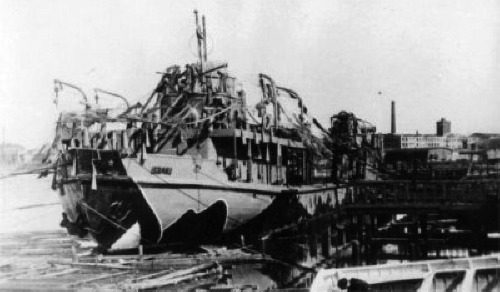
All ordered 264 Yd, Krasnoarmeysk (near Stalingrad) in 1938. Construction was of course for some suspended during the siege and resumed in 1944. They were shallow-draught netlayers, carrying also 50 M1926 or 40 KB mines and minesweeping equipment for good measure, so to act as jake of all trades. They had three diesels, one used for harbor operations: Two 140hp diesels on side-shafts and one 50hp diesel on the central shaft. Vyatka and Onega were armed by three 45mm/43 21K AA guns, two 12.7mm/79 DHSK HMGs and 50 mines. Mologa and Sukhona: same but four 12.7mm/62, Iset two HMGs, Tura a single 45mm/43 21K and two DSHK. Viatka, Onega and Mologa were stricken in the 1960s. Iset’ became a communication ship in 1942 and Tura was completed as a depot ship.
Specifications
Displacement 527 t. standard -? t. Full Load
Dimensions 56.80 m long, 9.80 m wide, 1.70 m draft
Machinery 2 shafts 4SD-19/32 diesels + 1 2SD-20/30 diesel, 330 bhp, 8.4 kts, 14 tons fuel, range 1280nm(4.5)
Armament See notes
Crew 54
USSR also operated a captured japanese netlayer, Tyumen’-Ula. This 1944 vessel built in Mitsubishi (Yokohama) as IJN 13-Go, was obtained as war reparation in 11.1946 and served as rescue vessel 7.1948. Probably scrapped in the late 1950s.
WW2 Soviet Minelayers
Less specialized, the role of minelaying could be given to any ship which could receive rails along the hull, which was the case of all cruisers and destroyers in service with the Soviet Navy in 1939. That’s why true specialized minelayers were rare, like in most navies:
–Profintern class cruisers: They carried 100 mines each.
-Krasnyi Kavkaz (1916): The rebuilt interwar cruiser also carried 100 mines.
-Kirov class (1935): All three groups six cruisers carried also 100 mines, and even 200 for the 1940 Chapayev.
-Novik class destroyers: About 54 built, the majority still active in WW2. carried 50-60 mines.
-Leningrad clas flotilla leaders: 80 mines
-Tashkent & Kiev class flotilla leaders: 80 mines
-Gnevnyi class Destroyers: 56 mines
-Storozhevoi class destroyers: 60 mines
-Ognevoi class destroyers: 96 mines
-Series II minelayer submersibles: 20 mines
-Series XI minelayer submersibles: 20 mines
-Series XIII/XIII bis minelayer submersibles: 20 mines
-Series XIV minelayer submersibles: 20 mines
-Yastreb class guardships: 20 mines
-Albatros class guardships: 20 mines
-Dzerzhinskiy class guardships: 24 mines
-Uragan class guardships: 48 mines
Note: The minesweepers themselves carried mines, see later.
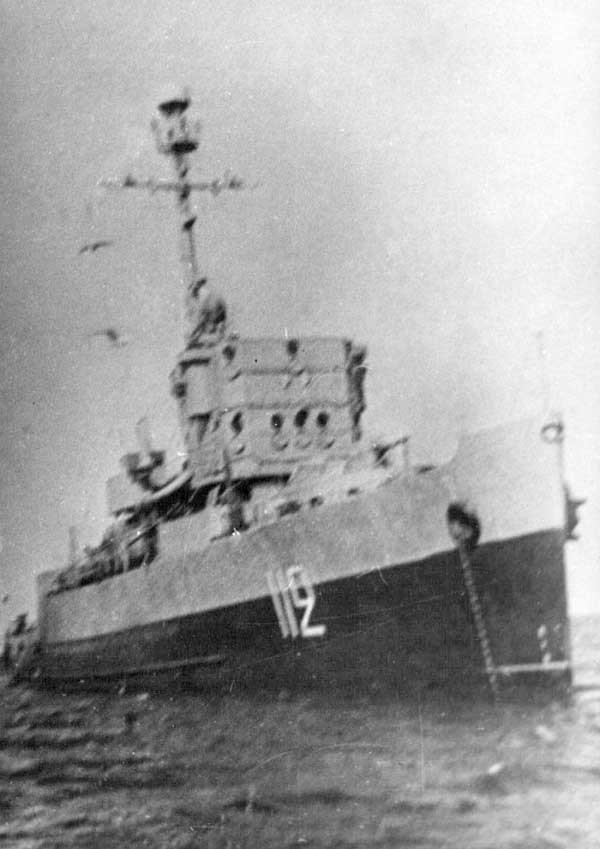
An example of Lend-lease minesweepers: T-112; note the two-tone 1945 allied livery -navsource). Originally planned as Agent (AMc 116), reclassified AM-139. Laid down 8 April 1942 by the Tampa Shipbuilding Co., Tampa, FL, Launched 1 November 1942 she was Completed 7 July 1943 and transferred to the Soviet Union, reclassified T-112 immediately, so she never was commissione din the USN. She was formally named Senior Lieutenant Vladimirov 13 April 1944. Returned to the USN in 1955 she was eventually struck from the Navy Register 1 January 1983 and abandoned on 31 January 1991.
Sources/Read More
weaponsandwarfare.com
man.fas.org
navypedia.org
Video about the Tral class
wio.ru battle records, Tral class
Fugas-class_minesweeper
Fugas-class on navypedia
Rusian & soviet Minesweepers on navypedia
Type 53U on russianships.info
On naval-history.net
D.A. Bertke, D. Kindell, G. Smith, “WORLD WAR II SEA WAR VOLUME 4 GERMANY SENDS RUSSIA TO THE ALLIES. Day-to-Day Naval Actions from June 1941 through November 1941
Mikhail Monakov, Jurgen Rohwer, “Stalin’s Ocean-going Fleet: Soviet Naval Strategy and Shipbuilding Programs 1935–1953
Платонов А. В. Энциклопедия советских надводных кораблей, 1941–1945 / А. В. Платонов. — СПб.: ООО «Издательство Полигон», 2002
“Miny VMF SSSR” (Mines of the Soviet Navy) by Yu. L. Korshunov and B. K. Lyamin
“Miny Rossiyskogo Flota” (Mines of the Russian Fleet) by Yu. L. Korshunov and Yu. P. D’yakonov
“Sovetskie Boevye Korabli 1941-45: IV Vooruzhnie” (Soviet Warships 1941-45: Volume IV Armament) by A.V. Platonov
Model kits
Kombrig Soviet WWII Patrol Ships Tral Minesweeper/Storm Sloop/MO-4 Hunting Craft/OD-200 Hunting Craft
AER Model Studio N40002 1:400
Nomenclature of Soviet Minesweepers/Minelayers
Marti (converted 1923)
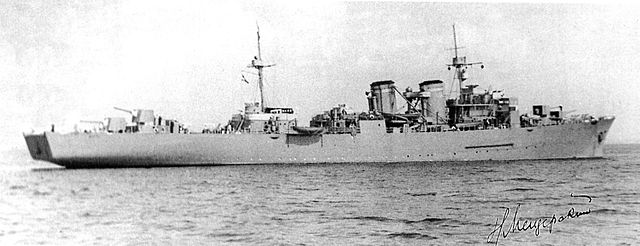
The 1893 Imperial Yacht Shtandard from Burmeister & Wain NyD, Copenhagen, completed 1896 was a known figures in the years preceding WW1. Captured after the civil war, it was for a time used an a floating exhibition, and mothballed until it was decided to convert her as a minelayer. This was performed at Marti Yard in Leningrad, so she was renamed after her namesake yard. The conversion started in 1932 and was completed on 25 December 1936. This was not a success: She carried too few mines on her 6,000 tonnes displacement and was too slow for effective service with the fleet. Naturally, she was commissioned with the Baltic fleet.
In 1941-42 she was attacked by the Luftwaffe and damaged. Repaired in 1943 she was used as a floating battery during the defence of Leningrad. After the war she was sent to Rostock in east Germany to receive a new powerplant and was used afterwards as the training ship Oka from 1957, after being an accommodation ship in the early 1950s. She was discarded in the late 1960s. By that time her hull was 70+ years old.

Conways profile, Marti in 1941
Specifications (1936)
Displacement 5,665 t. standard -6198 t. Full Load
Dimensions 122.30 m long, 15.40 m wide, 6.80 m draft
Machinery 2 shafts VTE, 4 boilers, 11,500 shp, 14 kts
Armament 4 x 130mm, 7x 75mm AA, 3x 45 mm AA, 3 MGs, 320 mines.
Crew 400
Note: The Soviet Navy also used the Suurop class, captured Estonian minelayers Suurop and Ristna in 1940. Both were recommissioned with the Baltic sea fleet. The first was sunk by the Luftwaffe in 1941 but the second survived as a training ship into the 1960s. Also the Soviet Navy captured the Romanian Admiral Murgescu in 1944 during the west black sea coast advance. She was renamed Don, and commissioned with the black sea fleet, returned after 1945 to Romania. In 1941, two 530 tonnes steam barges in construction in Kraznaya Sormovo Yard in Gorkyi were converted into netlayers, recommissioned with the baltic fleet with minelaying rails. Class: Onyega, Vyatka. Fate unknown.
Minesweeper Doroteya (1924)
No information available
Specifications
Displacement 443 t. standard -500 t. Full Load
Dimensions 46.20 m long, 6.50 m wide, 4 m draft
Machinery 2 shafts VTE, 2 cym boilers 400ihp, 8 kts
Armament 2 x 45mm/46
Minesweeper Dzhalita (1926)
No information available or photo. The two ships were specially built as experimental minesweepers, and very close in armament, powerplant and dismensions. Data from Conways 1922-47.
Specifications
Displacement 470 t. standard
Dimensions 40.50 m long, 6.30 m wide, 2.90 m draft
Machinery 2 shafts VTE, 2 cyl boilers 300 ihp, 8 knots
Armament 2 x 45mm/46
Tral (Fugas) class coastal minesweepers (1935)
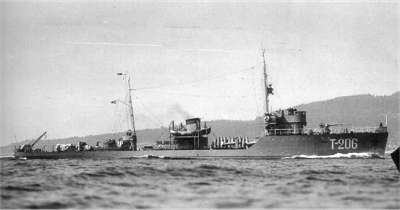
Arguably the most imporyant minesweepers class of WW2 for the Soviet Navy. Although less in numbers compared to the small coastal T301 Diesel Minesweepers, the “Fugas” class (soviet reference, Russian for the French word “Fougasse” an ancient incendiary defensive mine, was also known in the west, especially after the war, “Tral”. Amazingly, some, very modified were in service in the North Korean Navy as recently as 2015.
What made them stand apart was their simplicity of construction allowing large scale production, good armament and capabilities, making them also valuable escort vessels in addition of their roles as minesweepers or minelayers. In total 44 were built, before and during the war. The design specification was issued in 1930. The design was approved in 1931 under the project number 53, later 53-U and 58, retroactively applied in 1939 upon the new desigation policy. They were built in steel, using mixed welding and riveted elements. The crew compartment, which was rare at the time, was additionally coated by wood laminate for thermal isolation. The ASW protectin was assured by nine water-proof compartments below the waterline. They were intended to be livable for long cruises and had also a central heating system, a sauna and even a cinema room. No wonder why they were immensely popular.
They were equipped with a full Minesweeping geared, with three towed trails. Leading trails were tested but not adopted. Magnetic trails were fitted in 1944, and acoustic trails in 1945, to keep them relevant with the latest types of German naval mines. They had been equipped to deal also with magnetic-sensing mines by the addition of 3-section degaussing coils. Wartime lessons brought a serie of modifications, like an upgraded anti-aircraft armament while mines provision was reduced as well as the main shell storage. It was mostly intended to cope with stability issues, as the ship was calculated to be irrecuperable after listing to 38 degrees, with standard load. The crew also was armed, and could muster a small landing party with one Degtyaryov machine gun and 15 rifles, leading to many raids onshore in the baltic and pacific (notably Sakhalin). They were for some even convered as gunboats for onshore landings, armed with ten 45mm anti-tank guns on decks, and carried up to 600 infantry. Two ships could land a regiment and support the with the onboard artillery. In retrospect, the Fugas class was considered overall satisfactory. They had flaws, a reduced seaworthiness and stability, poor maneuverability, but these issues were gradually rectified during wartime. But not their draft of 2.75 m which prevented their use for riverine warfare and was overall clearly unsufficient for a minesweeper to deal with minefields. Many in fact, were lost while perfoming their minesweeping mission.
Production variants
- Project 3 (1930): 8 preserie vessels with a crew of 52 men.
- Project 53 (1933): 10 modified ships with a rigid ballast, better steering gear, and improved doors and hatches sealing
- Project 53-U (1937): 17 ships with a widened hull for stability increased AA, 66 men crew
- Project 58 (1937): 7 ships with improved compartmentalization and stability, better diesel engines (1,600 hp), main production version.
On a total of 44 ships built at 190, 196, 363, 370 Yards Leningrad, and 201 yard at Sebastopol, the last two were completed as escorts. T-1 to T-8 were in service with the Pacific Fleet, T-201 to T-221 in the Baltic fleet, T-401 to T-415 Black Sea fleet. Armament differed among models:
-The project 3 ships had a single 100mm/49 B-24, one 45mm/43 21K, two 12.7mm/79 HMG, 2 DCR.
-Project 53, 53u and 58 were armed the same, but T-217 was given a single 37mm/63 70K, and T-219, 220 had two, the later keeping its 45 mm guns.
All were given the ShT-1 and ZT-1 mechanical minesweeping gear and could carry 31 mines.
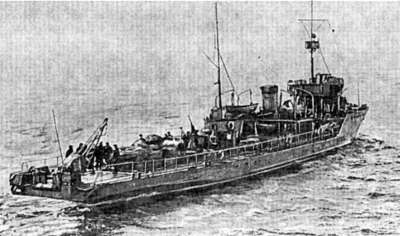
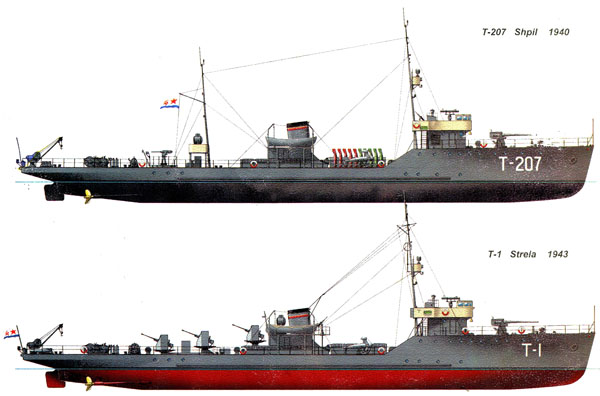
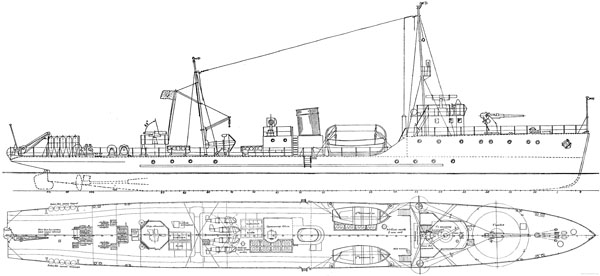
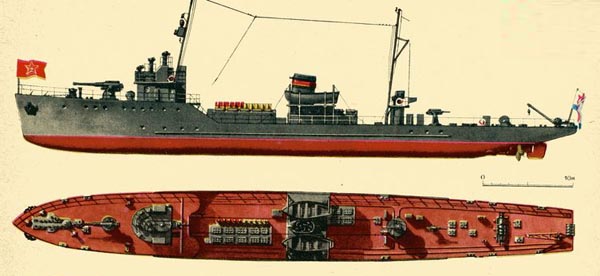
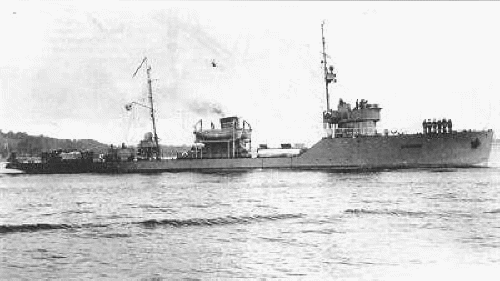

Specifications (All types)
Displacement 406-428 t. standard, 445-503 t. Full Load
Dimensions 62 m long, 7.20-7.40 m wide, 2-2.26 m draft
Machinery 2 shafts 42-BMRN-6 or BD diesels, 2800-2900 hp, 17.8-18.5 kts, 2840-330 nm
Armament 100mm, 45mm AA, 2x 12.7 mm AA, 2 DCR, 31 mines
Crew 42-47
Polukhin class fleet minesweepers (1935)
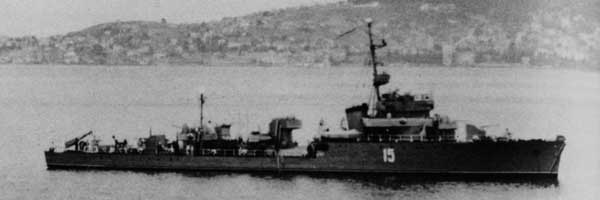
Polukhin off Turkey seen from a US ship, src: navsource.org
Project 59 (1939)
These large sea going minesweepers were called Project 59, of which two were built at xxx, T-250 Vladimir Polukhin, T-254 Vasiliy Gromov; and the modified version, Project 73K, after the war – 20 laid down, none complete during WW2 (see later). They were the T-251 Pavel Khokhryakov, T-252 Aleksandr Petrov, T-253 Karl Zedin, T-255 Andrian Zasimov, T-256 Vladimir Trefolev, T-257 Timofey Ulyantsev, T-258 Mikhail Martynov, T-259 Fiodor Mitrofanov, T-260 Luka Pankov, T-261 Pavlin Vinogradov, T-262 Stepan Griadushko, T-263 Semion Pelikhov, T-450 Pavel Golovin, T-451 Ivan Borisov, T-452 Sergey Shuvalov, T-453 Semion Roshal, T-454 Ivan Sladkov and T-455 Nikolay Markin.
These Fleet minesweepers were designed to assume reconnaissance minesweeping in long range, far away areas but also to assume mine warfare support for large squadrons. Project 59 was setup a top speed of 20kts which predetermined steam turbines and not diesels. Design work started in 1938 and in 1939 were laid down the first two at No370 and No363 yards in Leningrad, while in the black sea, Sevastopol Yard, no less than 20 hulls were laid down in 1941 at No201 yard. Delays for delivering turbines and boilers none were completed before the start of the war. In 1942-1943 however, the first two ships were eventually completed and commissioned. Eventually of the remainder 20, only 15 were completed after the war as project 73K.

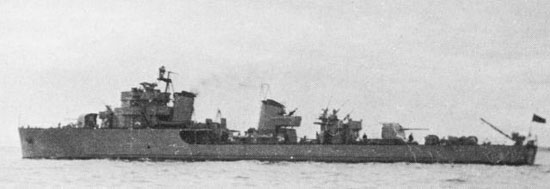

Project 59 Specifications
Displacement 690 t. standard, 880 FL
Dimensions 79.50 m long oa, 8.10 m wide, 2.50 m draft
Machinery 2 shafts DK1 geared steam turbines, 2 boilers 8000 hp, 22.5 kts, 191 tons oil, 2000 nm/11 kts
Armament 2x 100mm/54 B-24BM, 1x 45mm/43 21K, 3x 37mm/63 70K, 2x 20mm/70 Oerlikon Mk IV, 4x 12.7mm/79, 2 DCR (20 in store), 20 mines
Crew 125
Project 73K (1949)
Their steam turbines were replaced by GM diesels, they carried new modern sensors, a modernized and reinforced AA armament (2x 85mm/52 90K, 4x 37mm/73 70K, 4x 12.7mm/79 HMG, 2 DCT, 20 mines) and a brand new anti-mine equipment setup to deal with the latest magnetic mines: PT and MT-2 mechanical sweeping gears, TEM-1 magnetic and two BAT-2 acoustic minesweeping gear. Also the incomplete hulls of T-451 (Ivan Borisov) and T-452 (Sergey Shuvalov) were commissioned in December 1943 static landing barges, used until 1944. After WW2, T-250 Vladimir Polukhin and T-251 Vasiliy Gromov were given a modernized mechanical minesweeping gear, comprising a PT gear plus MT-2 mechanical, TEM-1 magnetic, and two BAT-2 acoustic minesweeping gear. They were also retrofitted with the Project 73K sensor suite: Giuys-1M, Zarnitsa and Rym radars, and the Tamir-5 sonar.
Project 73K Specifications
Displacement 703 t. standard -863 t. Full Load
Dimensions 78.60 m long, 8.10 m wide, 2.48 m draft
Machinery 2 shafts GM diesels 3200 hp, 17 kts, 3700 nm/16 kts
Armament See notes
Crew 118
T297 captured minesweepers (1939)
These were the ex-Virsaitis, Viesturs, and Imanta, former Latvian gunboats and minesweepers seized in 1940 and commissioned into the baltic sea fleet as T297, 298 and 299. The first was lost to a mine in December 1941, the the third also on July 1941. See more details about the Latvian fleet in the small fleets page.
T301/371 (MT) class coastal minesweepers (1942)
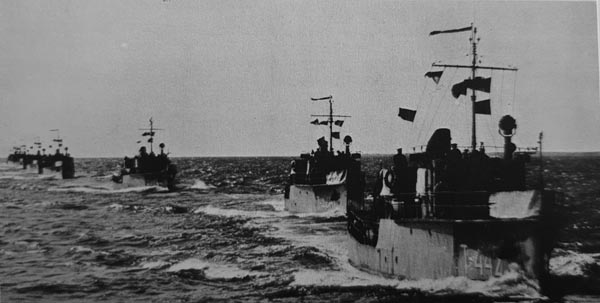
T442 and 446 at sea, Jerzy Michinski coll. via Conways.
Dsigned under the Soviet designation Project 253L, with Specifications issued in April 1942 by admiral Lev Galler. Initial they were planned by TsKB-32 but the design was judged unsatisfactory. It was transferred in 1943 to TsKB-51. Improvements resultied in Project 253L (for N. G. Loshchinskii, lead designer). These were badly needed in the Baltic Sea, and a pre-production of 32 was ordered on 12 April 1943 then full scale production in two shipyards from 12 June 1943. They became extremely successful and four more shipyards were also assigned to their production, from 31 October 1943.
MT-1 Introduced in June 194, it displaced 126.6 tons
MT-2 Introduced inApril 1944, 141.3 tons, but smaller engines (160 hp).
They were fitted with four mine-sweeping gears composed of two mechanical trails as well as magnetic and acoustic towed trails. A grand total of 92 T301 class vessels were delivered for the Baltic fleet. They were numbered T-222-249, T-351-391, T-434-441, T-459-479. T-387 was sunk by U-481 28 November 1944 but this was the only loss of the class in WW2. In 1946, seven of these were transferred to the Polish Navy. They were retired from 1956 and many converted into diving support ships.
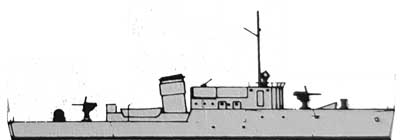
Conways profile.
Specifications
Displacement 126.6 t. standard -141.3 t. Full Load
Dimensions 38-39 m long, 5.50-5.70 m wide, 1.4-1.5 m draft
Machinery 2 shafts diesels, 3 props, 1440 hp, 14 kts.
Range 2,500 nmi (4,600 km) at 8.6 kn (15.9 km/h)
Armament 2x 45mm/46 21K, 4x 0.5in AA MGs, 18 mines
Armor 8mm (control room only)
Crew 32
T111 lend-lease minesweepers (1943)
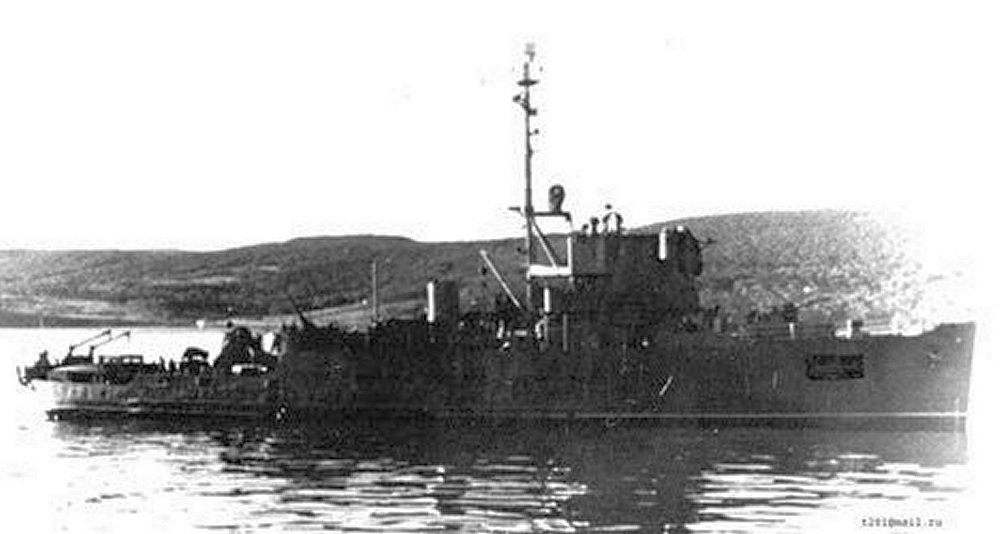
T218, ex-USS Perile
Also called “Starshkyi Leytnant Lekaryev” these were thirty-four US admirable class minesweepers loaned to USSR under lend-lease, starting with the frist ten in 1943, commissioned with the northern fleet as T-11-120. The next fourteen were sent to the Pacific fleet in 1945, T-114, 118 and 120 were all sunk by U-Boats in the Kara sea. T278 was lost in the Pacific (unknown causes), T279 hit a mine off Korea, three were scrapped after heavy damage after the wae, five were scuttled in 1956, the remaining were purchased in the 1950s so non returned to the US. No doubt their desig influence also the cold war generation of Soviet Minesweepers. Outside their identification numbers they all received names.
T108 lend-lease minesweepers (1944)
Fifteen RN and RCN motor minesweepers were sent to USSR in May-September 1945 via end-lease. A very late date as Germany was already defeated but this was to help the Soviet navy clean waters of mines in the arctic and baltic in order to maritime trade to resume as soon as possible. They were commissione din the northern fleet as T-101-T110 and T-121-122, and the T-193-202 sent to the black sea. They were all returned later in 1946. The types varied, see the WW2 British/Canadian sections for more.
T151 lend-lease minesweepers (1945)
These were forty-three ex-US YMS class coastal minesweepers, delivered in May-Setember 1945. 31 ended with the Pacific fleet as T-151-156, T581-592, T599-611 and two more batches of six delivered to the Baltic and Black sea fleet (T181-186 and T187-192 respectively). Two were lost in action, seven scrapped after the war in 1954, eleven more in 1956, twelve declared unseaworthy and scrapped in 1954, and eleven scuttle din the Barentz sea ynder USN supervision.


 Latest Facebook Entry -
Latest Facebook Entry -  X(Tweeter) Naval Encyclopedia's deck archive
X(Tweeter) Naval Encyclopedia's deck archive Instagram (@navalencyc)
Instagram (@navalencyc)





 French Navy
French Navy Royal Navy
Royal Navy Russian Navy
Russian Navy Armada Espanola
Armada Espanola Austrian Navy
Austrian Navy K.u.K. Kriegsmarine
K.u.K. Kriegsmarine Dansk Marine
Dansk Marine Nautiko Hellenon
Nautiko Hellenon Koninklije Marine 1870
Koninklije Marine 1870 Marinha do Brasil
Marinha do Brasil Osmanlı Donanması
Osmanlı Donanması Marina Do Peru
Marina Do Peru Marinha do Portugal
Marinha do Portugal Regia Marina 1870
Regia Marina 1870 Nihhon Kaigun 1870
Nihhon Kaigun 1870 Preußische Marine 1870
Preußische Marine 1870 Russkiy Flot 1870
Russkiy Flot 1870 Svenska marinen
Svenska marinen Søværnet
Søværnet Union Navy
Union Navy Confederate Navy
Confederate Navy Armada de Argentina
Armada de Argentina Imperial Chinese Navy
Imperial Chinese Navy Marinha do Portugal
Marinha do Portugal Mexico
Mexico Kaiserliche Marine
Kaiserliche Marine 1898 US Navy
1898 US Navy Sovietskiy Flot
Sovietskiy Flot Royal Canadian Navy
Royal Canadian Navy Royal Australian Navy
Royal Australian Navy RNZN Fleet
RNZN Fleet Chinese Navy 1937
Chinese Navy 1937 Kriegsmarine
Kriegsmarine Chilean Navy
Chilean Navy Danish Navy
Danish Navy Finnish Navy
Finnish Navy Hellenic Navy
Hellenic Navy Polish Navy
Polish Navy Romanian Navy
Romanian Navy Turkish Navy
Turkish Navy Royal Yugoslav Navy
Royal Yugoslav Navy Royal Thai Navy
Royal Thai Navy Minor Navies
Minor Navies Albania
Albania Austria
Austria Belgium
Belgium Columbia
Columbia Costa Rica
Costa Rica Cuba
Cuba Czechoslovakia
Czechoslovakia Dominican Republic
Dominican Republic Haiti
Haiti Hungary
Hungary Honduras
Honduras Estonia
Estonia Iceland
Iceland Eire
Eire Equador
Equador Iran
Iran Iraq
Iraq Latvia
Latvia Liberia
Liberia Lithuania
Lithuania Mandchukuo
Mandchukuo Morocco
Morocco Nicaragua
Nicaragua Persia
Persia San Salvador
San Salvador Sarawak
Sarawak Uruguay
Uruguay Venezuela
Venezuela Zanzibar
Zanzibar Warsaw Pact Navies
Warsaw Pact Navies Bulgaria
Bulgaria Hungary
Hungary

 Bundesmarine
Bundesmarine Dutch Navy
Dutch Navy Hellenic Navy
Hellenic Navy Marina Militare
Marina Militare Yugoslav Navy
Yugoslav Navy Chinese Navy
Chinese Navy Indian Navy
Indian Navy Indonesian Navy
Indonesian Navy JMSDF
JMSDF North Korean Navy
North Korean Navy Pakistani Navy
Pakistani Navy Philippines Navy
Philippines Navy ROKN
ROKN Rep. of Singapore Navy
Rep. of Singapore Navy Taiwanese Navy
Taiwanese Navy IDF Navy
IDF Navy Saudi Navy
Saudi Navy Royal New Zealand Navy
Royal New Zealand Navy Egyptian Navy
Egyptian Navy South African Navy
South African Navy






























 Ukrainian Navy
Ukrainian Navy dbodesign
dbodesign
When U.S. minesweepers were transferred to the Soviet Union in 1945, were they delivered to Russia or were they picked up by the Russians in Alaska? I am particularly interested in YMS-135/T-606. My father was the commander. When the vessel was transferred, his Russian counterpart gave him a Russian dress dagger which I now have.
For now i have nothing on this topic sorry. If i cover the matter in the following months i’ll let you know. I will for sure cover all classes of WW2 allied minesweepers.